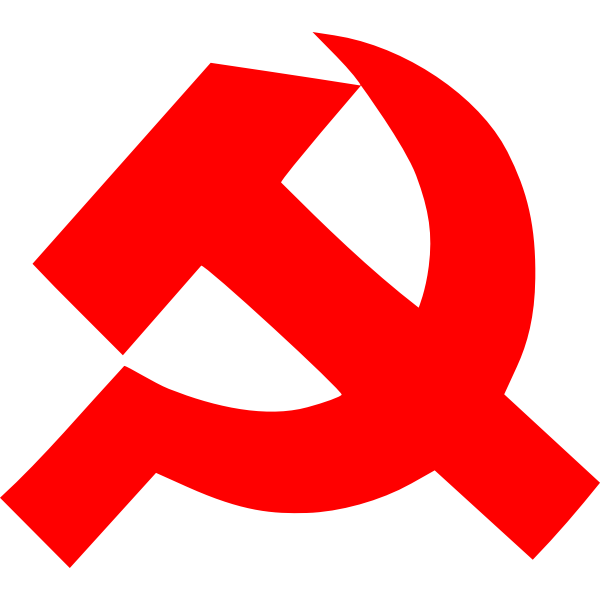Communism: The most misunderstood idea in education

Image used with permission from Google Commons
This symbol, the hammer and the sickle, is an iconic symbol of communist thought. It symbolizes the unification of the working class.
When taking any history or government class, one will most definitely hear of an idea entitled ‘communism.’ One may typically hear that it is an economic system in complete opposition to capitalism, where the government has control of all aspects of the economy, where there is complete equality between individuals, where all individual property is destroyed or where all religion is forcefully eliminated. Unfortunately, while social studies classes do, indeed, get the gist of how much of a catastrophe communism was in the last century, what every class obfuscates is what the theory of communism actually is. Most, if not every, characteristic of communism one learns in the United States educational system is not accurate. To counter this, it is of utmost importance to internally analyze and expose these myths.
Myth 1: “Communism is where everyone is equal; communism is egalitarian.”
This is probably the most widespread and virulent of myths. Communism never desired complete equality or egalitarianism. What communism desires to achieve is the elimination of social class differences; it never wanted to place everyone on ‘equal footing’ as that would eliminate individual differences. Everyone loves to repeat “from each according to his ability, to each according to his needs,” but this presupposes that individuals have both different abilities and needs.
We can see this if we look into Karl Marx’s “Critique of the Gotha Programme,” where he links the idea of equal rights to a purely ‘bourgeois,’ or capitalist, way of thinking. If you put two workers on equal footing under the term ‘right,’ Marx explains that this ignores that different workers have different abilities from one another, so it wouldn’t make sense to have equal standards to compare them. While everyone loves to regurgitate the aforementioned quote, if they looked on the same page in the original text, they would observe an even more interesting explanation to the phenomena of equality: “This equal right is an unequal right for unequal labor. It recognizes no class differences, because everyone is only a worker like everyone else…It is, therefore, a right of inequality, in its content, like every right.”
Similarly, Friedrich Engels, who wrote “The Communist Manifesto” with Marx, explains, in an 1875 letter to August Bebel, that living conditions always foster inequality, which can never be completely eliminated. This is why Engels claims that proposing social equality as a political goal is a “one-sided French concept,” which always produces nothing but “mental confusion.”
While it is abundantly clear that the founders of communism don’t believe in equality as a political goal, they also don’t believe in equal distribution of wealth or resources, something that one typically hears in social studies courses. For example, Vladimir Lenin, a former communist leader of the Soviet Union, argues a position of equality slightly different from Marx where he explains that while the abolition of class distinctions allows everyone to have an equal opportunity for the resources used to make products, this doesn’t mean that everyone will have equal outcomes as individuals are not equal in mental or physical strength. Similarly, Joseph Stalin, another former communist leader of the Soviet Union, in an interview with Emil Ludwig, not only explains that equal outcome is unknown to Marxism, but Stalin also claims that the “roots of equalitarianism lie in the mentality of the peasant, in the psychology of share and share alike, the psychology of primitive peasant ‘communism.’”
From this, we can gather that equity, equality, and egalitarianism are actually liberal concepts, not leftist ones. This is one of the best examples of the American social studies curriculum distorting what ideas actually are. If anything, capitalism has equalized everyone in their oppression. Reading “The Communist Manifesto” for the first time is shocking for many, including myself, for a multitude of reasons, but especially because the idea of inequality between individuals or sexes is shunned in the first few pages: “The bourgeoisie, wherever it has got the upper hand, has put an end to all feudal, patriarchal, idyllic relations.”
Myth 2: “Communism tries to destroy religion as it poses a threat to the state.”
“Religion is the opium of the masses.” Many love to attribute this quote to Marx, but this is actually closer to what Lenin said. While Marx did say those words, there is a sentence between ‘the’ and ‘opium’ which is always omitted. By repeating the edited quote, many people end up believing that Marx (and communism for that matter) are polemically against religion. What Marx actually meant is that religion is produced by the government in order to quell individual, spiritual anxieties. Religion, for Marx, gives people the strength to move on with their life in a capitalist society, although at the expense of dulling problems of oppression and revolution. This is why Marx claims that religion is “the heart of a heartless world, and the soul of soulless conditions.”
However, this does not mean that communism tries to destroy religion because it poses a threat to the power of revolution. Rather, Marx and Engels explain that religion becomes superfluous under communism because there is no state. Religion can’t pose a threat to the government because a government doesn’t exist under communism. Even if we look at Lenin, he doesn’t think that religion should be correlated with the state, but rather as a private affair. In this sense, even if the state is abolished, “everyone must be absolutely free to profess any religion he pleases, or no religion whatsoever.”
Myth 3: “Communism tries to destroy all individual property.”
This is also something one typically hears in a social studies class or in a regular political conversation. However, one can relinquish this misinterpretation after a quick reading of “The Communist Manifesto.” Marx and Engels claimed that “the abolition of existing property relations is not at all a distinctive feature of communism.”
What Marx and Engels mean is that they don’t care if an individual worker has their own property. Rather, communism only tries to abolish bourgeois, or capitalist, property (‘private property’ in other words). This is a crucial distinction, and this is how one must understand Marx and Engels’ famous claim that the abolition of private property is a summary of the theory of communism.
Myth 4: “Communism is in strict opposition to capitalism; communism hates capitalism.”
This myth is arguably as destructive as the first. For Marx, communism is not situated in logical opposition to capitalism; rather, communism emerges from capitalism through a natural process. Capitalism, in this sense, is necessary in that it gives way to communism. This is partly why Marx and Engels praise capitalism in the first few pages of “The Communist Manifesto”: “The bourgeoisie cannot exist without constantly revolutionizing the instruments of production…Constant revolutionizing of production, uninterrupted disturbance of all social conditions, everlasting uncertainty and agitation distinguish the bourgeois epoch from all earlier ones.”
In other words, Marx and Engels explain that capitalism is incredibly productive. Though one may point out that they also claim that capitalism disturbs social relations, this is actually a good thing for Marx and Engels. In a speech on free trade, Marx explains that he is sanguine about free trade, which he considers a capitalist phenomenon, because it is destructive and pushes social class antagonism to its breaking point. For Marx, internal contradiction and conflict simultaneously act as capitalism’s motor of production as well as its exterminating angel. In fact, Marx, and a majority of communists, desire to intensify these contradictions of capitalism, to “accelerate the process” as neo-Marxists Gilles Deleuze and Félix Guattari would say.
While there are a lot of specifics to be commented on in regards to misinterpretations that the United States educational system has propagated in relation to communism, the one thing that must be understood by uncovering these myths is that communism is not a static system with a fixed, easy-to-understand definition. While the educational system likes to purport that communism is a system with fixed characteristics that eventually becomes conservative because future progress cannot be observed on the horizon, communism itself conceives of its own system differently. “We call communism the real movement which abolishes the present state of things,” as Marx and Engels said.
Your donation will support the student journalists of Thomas S. Wootton High School. Your contribution will allow us to purchase equipment and cover our annual website hosting costs.






